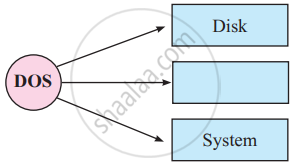Advertisements
Advertisements
प्रश्न
List and explain types of File Systems used in OS.
उत्तर
Types of File Systems used in OS
Windows file systems:
- FAT:
FAT (File Allocation Table) is one of the simplest types of a file system. It consists of a file system descriptor sector (boot sector or superblock), a file system block allocation table (referred as File Allocation Table) and plain storage space to store files and folders. - NTFS:
NTFS (New Technology File System) was introduced in Windows NT and is major file system for Windows at present. This is a default file system for disk partitions and the only file system that is supported for disk partitions over 32GB. The file system is quite extensible supporting many file properties, including access control, encryption etc. Each file on NTFS is stored as file descriptor in a Master File Table and file content. - ReFS: ReFS (Resilient File System) is the latest development of Microsoft presently available for Windows 8 Servers. File system architecture absolutely differs from other Windows file systems and is mainly organized in a form of B+-tree. ReFS has high tolerance to failures due to new features included into the system
Linux file systems
- Ext2, Ext3, Ext4 - 'native' Linux file system. This file system falls under active developments and improvements. Ext3 file system is just an extension to Ext2 which uses transactional file write operations with a journal. Ext4 is a further development of Ext3, extended with support of optimized file allocation information (extents) and extended file attributes. This file system is frequently used as a 'root' file system for most Linux installation
- ReiserFS - alternative Linux file system is created to store huge amount of small files. It has good capability of files search and enables compact files allocation by storing file tails or small files along with metadata in order not to use large file system blocks for the same purpose.
- XFS - file system derived from SGI company and was initially used for company’s IRIX servers. Now XFS specifications are implemented in Linux. XFS file system has great performance and is widely used to store files.
- JFS - file system is developed by IBM for the company’s powerful computing systems. JFS1 usually stands for JFS, JFS2 is the second release. Currently this file system is open-source and implemented in most modern Linux versions.
shaalaa.com
Introduction to Operating System (OS)
क्या इस प्रश्न या उत्तर में कोई त्रुटि है?
APPEARS IN
संबंधित प्रश्न
What is File System?
Context Switching is a term related to........... Management
(i) Process
(ii) Memory
(iii) Information
(iv) Device
Explain Virus Detection, Removal and Prevention
What functions are performed by Memory Management of Operating System ?
Explain following terms of VDU: Dumb Terminal
Explain the following process states :
Running State
Write a short note on Paging.
Complete the following activity.

Match the following.
| 'A' | 'B' |
| (1) IS | (a) change directory |
| (2) FTP | (b) Translates Network Address |
| (3) CD | (c) List of Directory |
| (4) DNS | (d) To transfer file on interent |
Identify the usage of Operating Systems.
